TANZANIA
History

History

Popular destinations TANZANIA
| Pemba | Zanzibar |
History
Antiquity and Middle Ages
In the Oldowai Gorge 1.8 million year old remains of humanoid beings (including Zinjanthropus) have been found. The original inhabitants of mainland Tanzania have now almost disappeared. They were hunters and gatherers, related to the South African San (Bushmen).
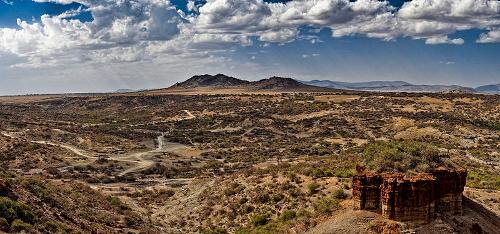 Oldowai Gorge TanzaniaPhoto: Noel Feans CC 2.0 Generic no changes made
Oldowai Gorge TanzaniaPhoto: Noel Feans CC 2.0 Generic no changes made
They were expelled by Bantu-language peoples, mostly farmers, and Nilotic-speaking pastoralists such as the Maasai. This immigration to the Tanzanian territory started about 3000 years ago and continued until about 1850.
From the 9th century onwards, Arabs settled along the coast, and the mixing of the Bantu languages and Arabic gave rise to Kiswahili, a commercial language or "lingua franca" that was understood and spoken by almost all native inhabitants of Tanzania. Portuguese dominated the trade between 1498 and 1828, when they were finally defeated by the Arabs.
Slaves were the most important commodity at one point. Many slaves were shipped to sugar plantations on the nearby islands of Zanzibar, Mauritius and Réunion, to Arab countries, as well as to America and the Caribbean. The "peak" of the slave trade was in the 1960s. Bagamayo was then the main slave market in mainland East Africa.
German rule
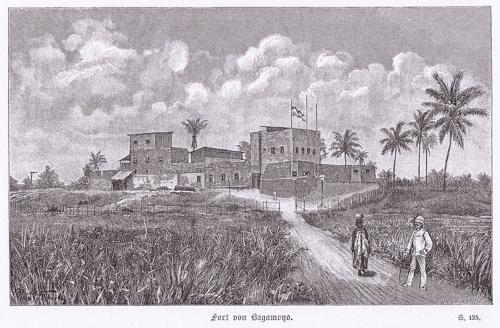 Fort Bagamoyo, TanzaniaPhoto: Rudolf Hellgrewe in the public domain
Fort Bagamoyo, TanzaniaPhoto: Rudolf Hellgrewe in the public domain
In 1884 the German Carl Peters was commissioned by the Deutsche Ost-Afrika Gesellschaft into the East African interior. On behalf of Chancellor Bismarck, treaties were concluded with local chieftains, who could therefore count on "protection". However, when this resulted in the prohibition of local traditions and the shooting of a black man, a revolt broke out in 1888, which was, however, brutally crushed by the "Reichsregierung". The Sultan of Zanzibar saw his control over large parts of the mainland lost and enlisted the help of the British. However, they counterproductive and in 1890 even concluded an alliance with the Germans, making Tanganyika (now: Tanzania, Burundi and Rwanda) a German protectorate and Kenya, Uganda and Zanzibar within the British sphere of influence. A narrow coastal strip on the mainland remained for the poor sultan, and Great Britain's Queen Victoria gave Mount Kilimanjaro to the German Emperor's grandson.
The colonization of Tanganyika by the Germans was quite difficult, especially in the interior. Important for the area was the construction of a railway line from the coast to a fertile area near Kilimanjaro. Construction of the railway started in 1891 and lasted until 1911. In addition, the cultivation of commercial crops such as coffee and sisal was stimulated and financed. Cotton did not yield much due to the poor soil quality, and when people were forced to grow cotton in the southern coastal areas, the Maji Maji uprising broke out in 1905. This cost the lives of more than 70,000 Tanganyicans, not only through war but also through hunger and disease.
However, the Germans soon realized that forced labor did not work here and stimulated small-scale African agriculture, with the additional consequence that the unrest among the population decreased sharply. This allowed, for example, cotton cultivation to develop well south of Lake Victoria, the residential area of the Sukuma. The cotton trade was almost entirely controlled by Asian traders at the end of the nineteenth century.
Tanganyika under British mandate
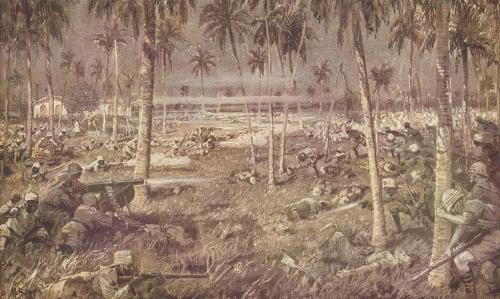 Battle of Tanga (1914) between British and German troops, TanzaniaPhoto: Public domain
Battle of Tanga (1914) between British and German troops, TanzaniaPhoto: Public domain
The First World War had a profound effect on German rule in East Africa. The German army lost to the British time and again, but the British did not manage to chase the Germans out permanently.
However, the 1919 peace treaty stipulated that Germany should give up its claims to East Africa and all other colonies. Tanganyika was then placed under British mandate, on the understanding that the Rwanda-Urundi area fell into Belgian hands. However, the British did not find their new mandate area interesting and, in combination with the global economic crisis, Tanganyican agriculture suffered badly from the lack of investment and falling export prices.
During the Second World War, the Tanganyican economy improved again. British troops in East Africa needed a lot of food, but also rubber. Even after the war, Tanganyika remained interesting to the British, because large sales areas had disappeared due to the independence of India.
Tanganyika on the way to independence
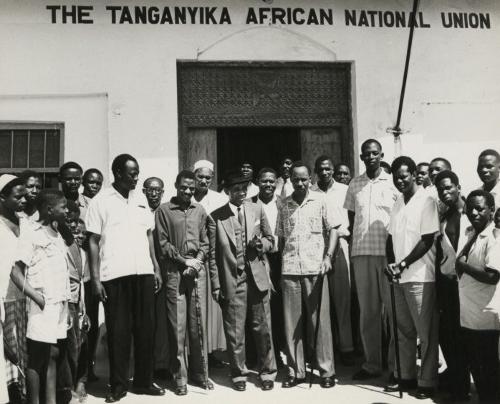 Tanganyikan African National UnionPhoto: The National Archives UK Open Government 1.0 no changes made
Tanganyikan African National UnionPhoto: The National Archives UK Open Government 1.0 no changes made
After World War II, all League of Nations mandate territories were placed under the supervision of the United Nations. Its purpose was to gradually give those areas self-government and guide them towards independence. The first Legislative Assembly elections were held in Tanganyika in 1948.
In 1956, Julius Kambarage Nyerere, the future president, traveled to the United Nations in New York to advocate the independence of Tanganyika, which he was a strong supporter of. Ultimately, the United Nations recognized the right to self-determination and Nyerere's national political movement Tanganyika Africa National Union (TANU) was also recognized as a national political movement. This desire for independence dates back to the time between the two world wars and was prevalent across the country. The 'indirect rule' form of governance used by the British in particular caused a lot of bad blood. This meant that the British appointed local chiefs, even in areas where these chiefs did not mean the common population. The chiefs were therefore accused of collaborating with the colonizer.
Also for economic reasons things did not work out between the British and the Tanganyicans. The production of agricultural crops had to be further increased and therefore the small farmers were driven from their land to build large plantations. In addition, people were forced to apply other agricultural methods, which turned out wrong due to a lack of knowledge. In order to withdraw from the power of the British and the chiefs, the farmers in the main production areas united in cooperatives. This also increased the opportunity to resist. The British viewed these developments with mixed feelings, which entailed both advantages and disadvantages. Ultimately, however, the cooperatives would turn against the British rulers for good.
After the farmers, the dock workers in the cities revolted against the British. Their main demand was a wage increase, and both railway workers and teaching staff would eventually strike with the dockers. To prevent the strikes from spreading to other parts of the country, the British decided to make concessions. They agreed to the pay rise and allowed the formation of unions. In 1955, the Tanganyika Federation of Labor (TFL), a federation of various trade unions, was established under the leadership of Rashidi Kawawa, the later Prime Minister. The first national political party, the Tanganyika African National Union (TANU), was also established in 1954, the successor to the anti-colonial movement Tanganyika African Association (TAA), which was founded in 1922.
Rise of Julius Nyerere
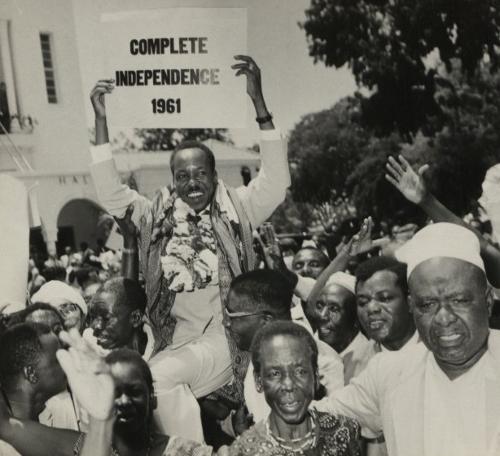 Tanganyika: Julius Nyerere holding a sign demanding complete independence from the British Empire in 1961Photo:The National Archives UK Open Government 1.0 no changes made
Tanganyika: Julius Nyerere holding a sign demanding complete independence from the British Empire in 1961Photo:The National Archives UK Open Government 1.0 no changes made
Julius Nyerere was the great man of this movement, for as early as 1940 he had demanded more attention from the British for the development of the African population and in 1954 a draft constitution of the TAA was even published.
In 1959 Tanganyika got a cabinet for the first time, eventually with five ministers from the TANU. In 1960, the general election was won by TANU, with 70 out of 71 seats, with Nyerere as Prime Minister. In May 1961, the country gained full self-government and on December 9, 1961, the independent Tanganyika was proclaimed, with Nyerere as president.
Tanzania initially went well under Nyerere. Nyerere was popular and managed to maintain unity among the more than a hundred population groups, with the TANU as a binding agent. He even resigned a month after the transfer of power to organize the TANU all over the country. His place was taken by former union leader Rashidi Kawawa, who immediately overhauled the colonial administrative system.
Developments on Zanzibar
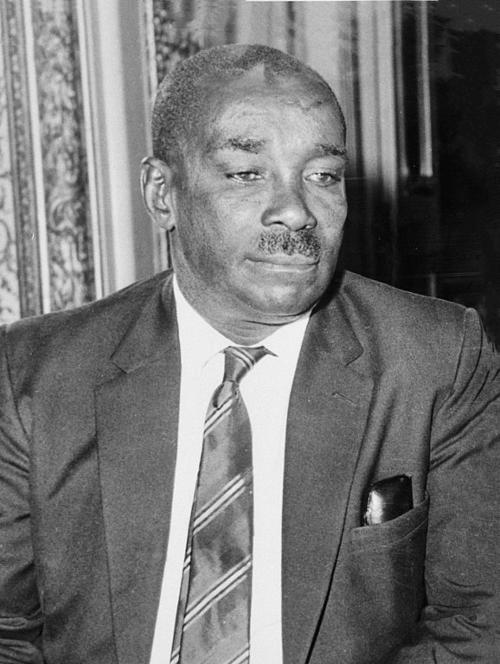 Karume ZanzibarPhoto: Unknown CC 3.0 Netherlands no changes made
Karume ZanzibarPhoto: Unknown CC 3.0 Netherlands no changes made
On the island of Zanzibar, developments did not go so fast and the existing hierarchy remained intact for quite some time. Here the Europeans occupied the highest posts and the Africans were kept under control and put to work on the farmland. Two years after Tanganyika, in December 1963, Zanzibar and Pemba also gained independence, but the government only lasted one month.
In January 1964 the black population revolted against the oppressive Arabs and the sultan was expelled. Thousands of Arabs were slaughtered and others fled to Oman and other Gulf countries.
Power was now in the hands of the Afro-Shirazi Party (ASP), which included Africans from the mainland and Arabs. The new regime, led by Sheikh Abeid Karume, forged close ties with communist countries such as the GDR and China, much to the concern of the United States.
After all, it was the time of the Cold War and they wanted to avoid a second "Cuba" at all costs. Nyerere was pressured by the Americans to form a union with Zanzibar and Pemba, and on April 22, 1964, the time had come: Tanganyika and Zanzibar together formed the United Republic of Tanzania, while Zanzibar retained a large degree of autonomy.
However, this autonomous position is still causing problems to this day. For example, Zanzibar has its own president and its own government. The president of Zanzibar is also vice-president of the United Republic of Tanzania. There have been several coup attempts over the years, including in 1984 and 1988. Karume was murdered as early as 1972; he was succeeded by Aboud Jumbe.
These coups were triggered by discontent, because the economy of Zanzibar was much worse than the economic situation of Tanzania. The large differences between the African and Arab population groups also played a major role in this. The relations between the main island of Unguja and Pemba are also far from good.
Preparations for a multiparty system in 1992 initiated a process of secession by islanders. The first election under the new system was held in Zanzibar in 1993. The elections were won by the Revolutionary Party of Tanzania (CCM), but boycotted by almost the entire opposition.
President Nyerere
In 1965 Nyerere declared Tanzania a one-party state; he was still deeply convinced that in order to maintain unity in the country, one political party was best. In Tanganyika only the TANU and in Zanzibar only the Shirazi party was admitted.
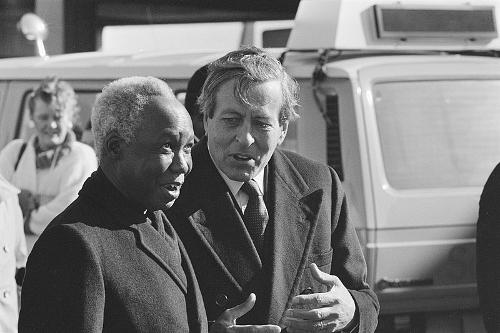 President Nyerere and Prince Claus of the NetherlandsPhoto: Rob Croes/Anefo in the public domain
President Nyerere and Prince Claus of the NetherlandsPhoto: Rob Croes/Anefo in the public domain
In addition, he was also a little afraid of his own position. After independence, economic development lagged behind expectations and that did not benefit his popularity. The many millions of small farmers in particular were poorly off and received almost no government attention. Industrial development also lagged far behind and the sale of agricultural products abroad stalled. Domestic unrest led to an army mutiny in 1964 and trouble at the University of Dar-es-Salaam in 1966. However, with the help of British troops and Nyerere's verbal talents, these crises were quickly averted.
On February 5, 1967, the Arusha Declaration was published by the Executive Committee of TANU. Some of the main points of the future policy were self-reliance (self-reliance) and "ujamaa" (family sense). It also included a leadership code and characteristics of Tanzanian socialism: an active role for the state, no more exploitation of the peasants and one could no longer depend on foreign countries.
Immediately after the Declaration was published, all banks and many large companies were nationalized. Also notable were the establishment of so-called Ujamaa villages, which were based on the old values and traditions of the family communities in the countryside. In the villages, the land could also be worked jointly and all kinds of social facilities could be realized more easily.
The result was a massive migration of more than 3 million Tanzanians who moved to the new villages. Nyerere's plans were received with great enthusiasm both nationally and internationally.
Seventies and eighties
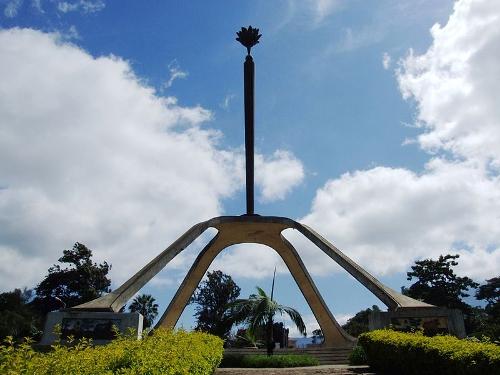 Arusha Declaration Monument TanzaniaPhoto: Jonathan Stonehouse CC 2.0 Generic no changes made
Arusha Declaration Monument TanzaniaPhoto: Jonathan Stonehouse CC 2.0 Generic no changes made
From the early 1970s, however, it soon became clear that "Arusha" and ujamaa would not bring the hoped-for economic prosperity and prosperity. Both external and internal factors were to blame for the economic downturn. In terms of trade position, Tanzania was hit hard by the rise in oil prices and the prices of export products lagged far behind those of imports. The disintegration of the East African Community in 1977 did not help the economic situation either, and a war with Uganda in 1978 brought defense spending to almost 25% of national income. The weather was also not cooperative due to heavy floods and long periods of drought.
In 1977 the TANU and the Afro-Shirazi Party of Zanzibar merged into the CCM, the Chama Cha Mapinduzi, the Party of the Revolution.
The ujamaa project was also unsuccessful internally: due to the applied shifting agriculture, the soil quickly became depleted, resulting in a decline in agricultural production. Moreover, the land in the vicinity of the new villages was by no means always suitable for agriculture and there was often a shortage of water. The closure of farmers' cooperatives in 1976 was not a smart move either. Their role was taken over by state trading companies, which were soon rife with corruption, inefficiency and bureaucracy.
All these factors led to a deep crisis in Tanzanian society. The Tanzanians lost faith in their leaders, reinforced by continued inflation and lagging wages. Almost everyone was forced to do some extra work, and little was left of the once socialist stronghold in Africa. From the early eighties of the last century there was for the first time open resistance against the party and government.
War broke out with neighboring Uganda in 1979, after troops of dictator Idi Amin invaded Tanzania. Tanzanian forces expelled Amin with the help of Ugandan exiles.
For example, in 1982 an airplane was hijacked, and hijackers demanded the resignation of the government. Less than a year later, a plot against the government was discovered, but even now it had no consequences for the government of Nyerere. Nyerere was succeeded by Ali Hassan Mwinyi in 1985, as real economic reforms were highly desirable. Despite allegations of things like corruption and abuse of power, Mwinyi remained in his post for ten years and helped Tanzania through a difficult period in all respects. He implemented economic reforms and there was also more political freedom.
The nineties
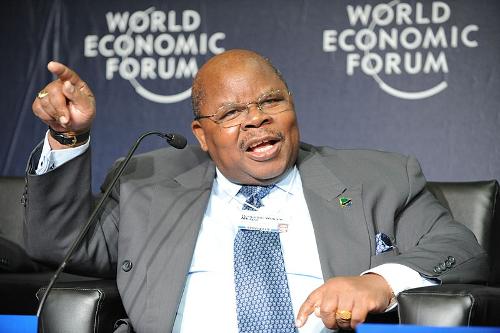 Mkapa TanzaniaPhoto: World Economic Forum/Photo by Aly Ramji / Mediapix CC2.0 Generic no changes made
Mkapa TanzaniaPhoto: World Economic Forum/Photo by Aly Ramji / Mediapix CC2.0 Generic no changes made
Due to the monopolistic position of the CCM, the call for a multiparty system arose, something which was finally realized in 1992.
In 1994 half a million refugees from civil war-ravaged Rwanda crossed the border into Tanzania, as did tens of thousands of refugees from Burundi. The Rwandans were again forced to return to their country in December 1996.
In 1995, elections were held for the first time since the 1960s, with multiple parties taking part. The election was won by the CCM's Benjamin Mkapa, many say for a lack of anything better. Mkapa was the replacement for Ali Hassan Mwinyi. Fifteen parties took part in the chaotic elections, and this political division obviously played into Mkapa's hands.
The irregularities in the elections were the reached a climax in the capital Dar-es-Salaam: they had to be repeated there. Ultimately, the CCM got 215 of the 265 seats. The cabinet put together by Mkapa was very surprising; many technocrats and the old guard was almost completely dismissed. Almost all regions were also represented in the cabinet.
On March 14, 1996, the presidents of Tanzania, Kenya and Uganda inaugurated the secretariat of the East Arican Co-operation in Arusha. The new EAC also aims to achieve close cooperation in the areas of transport, communication, agriculture, livestock, fishing, industry and some other, less important economic sectors.
In May 1996, President Salmin Amour of Zanzibar was sworn in as a member of the Union Government. In late 1997 and early 1998, Tanzania was hit by severe flooding that destroyed roads and lost crops. At the end of 1998, food supplies for 300,000 people were at risk, especially in the Eastern and Northern regions, due to drought and a plant disease that destroyed part of the crop. In August of that year, Osama bin Laden's Al-Qaida terrorist group attacked the US embassy in Dar-es-Salaam. Twelve people were killed and more than eighty injured.
Former president Nyerere passed away on 14 October 1999, who, as a mediator, until his death, tried to end the civil war in neighboring Burundi. Tanzania was home to 300,000 Burundian refugees and in 1999 also received at least 120,000 refugees from the Democratic Republic of Congo.
21st century
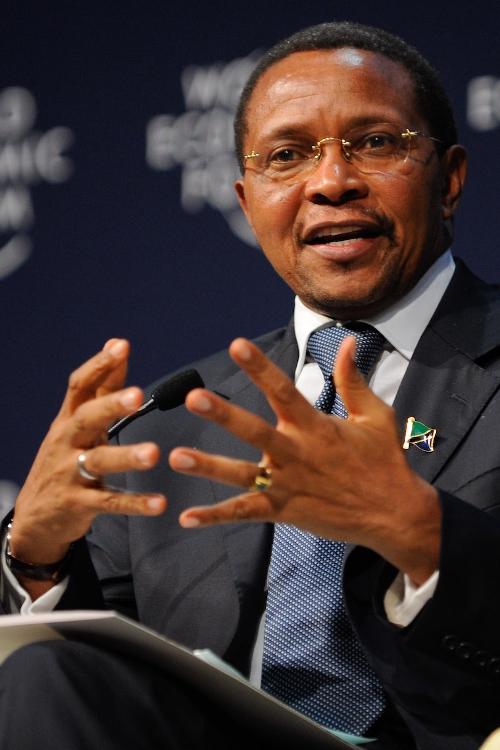 Kikwete, TanzaniaPhoto: World Economic Forum/Photo by Matthew Jordaan / Mediapix CC 2.0 Generic no changes made
Kikwete, TanzaniaPhoto: World Economic Forum/Photo by Matthew Jordaan / Mediapix CC 2.0 Generic no changes made
In October 2000, President Mkapa was re-elected with 69% of the vote and the CCM increased its majority in parliament to 85%. While the elections went well overall, Zanzibar was once again experiencing chaos, fraud and violence. CCM candidate Amani Karume was elected president of Zanzibar, but the CUF did not recognize this result and refused to sit in the House of Representatives.
At the end of January 2001, the opposition called for peaceful demonstrations, which, however, got out of hand and resulted in up to 30 deaths on Pemba. That is why partial elections in Pemba in May 2003 were eagerly awaited. The elections were conducted peacefully and democratically, with the CUF as the big winner, winning all seats.
In fact, only two political parties set the political scene in Tanzania, in addition there are a number of smaller parties. The two most important are the Chama Cha Mapinduzi (CCM) and the opposition Civic United Front (CUF); the latter has many followers among Muslims, especially on Pemba and in the coastal regions. In the 2005 elections, 197 of the 223 seats in parliament went to CCM and CCM presidential candidate Jakaya Kikwete won with 80% of the vote. The CUF currently holds 19 seats in Parliament.
In 2008, the head of the central bank Daudi Ballali is fired and in February the president changes the government, all because of corruption scandals.
In November 2009, Tanzania, together with Kenya, Uganda, Rwanda and Burundi, formed an alliance to promote trade and the free movement of people between these East African countries. President Kikwete will be re-elected in October 2010. In March 2012, large oil reserves are discovered off the coast of Tanzania. Six ministers were fired for corruption by President Kikwete in May 2012. In March 2013, Chinese President Xi Jinping also visited Tanzania during his Africa trip. In November 2013, an illegal amount of ivory was found at Chinese traders in Dar es Salaam. In November 2015, John Magafuli wins the presidential election. In April 2016, Tanzania and Uganda decide to build the first East African oil pipeline. In February 2017, the government banned several private health centers from fighting HIV and AIDS. The government has accused the clinics of promoting homosexuality. In 2018, Denmark suspends aid to Tanzania due to the government's intolerant attitude towards homosexuality. Vice-President Hassan took over in March 2021 on the death of President John Magufuli. Samia Suhulu Hassan was elected as Mr Magufuli's running mate in 2015 and again in 2020. A contrasting figure to her abrasive and impetuous predecessor, she is due to serve out the remainder of his five-year term.
Sources
Heale, J. / Tanzania
Marshall Cavendish
Tanzania
Cambium
Vlugt, B. / Kenia, Tanzania, Zanzibar
Gottmer/Becht
Waard, P. de / Reishandboek Tanzania
Elmar
CIA - World Factbook
BBC - Country Profiles
Copyright: Team The World of Info